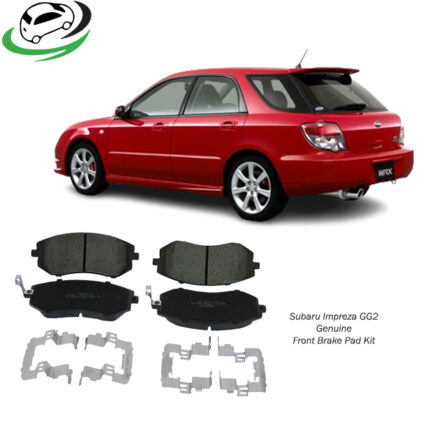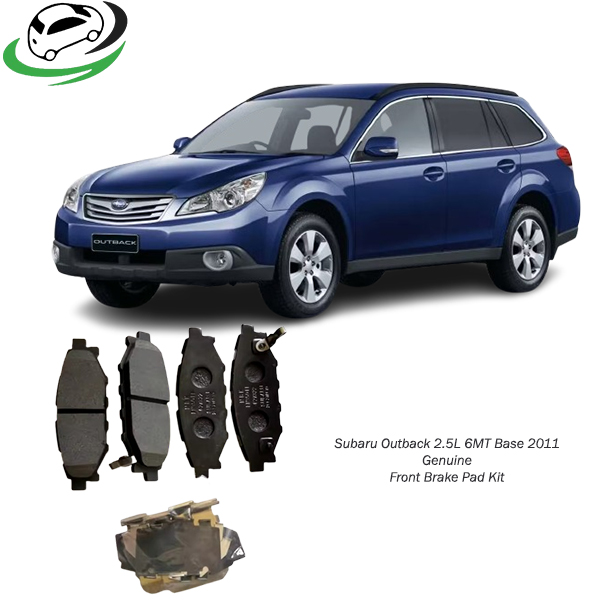-12%
Get Subaru Outback 2.5L 6MT Base 2011 Front Brake Pad Kit 26696AG031
A Front Brake Pad Kit is an essential part of any vehicle’s braking system, designed to ensure optimal stopping performance and safety. This kit typically includes high-quality brake pads engineered for specific makes and models, offering a precise fit and efficient operation. Here’s a breakdown of the function, composition, types, benefits, installation process, maintenance tips, and key considerations when selecting a front brake pad kit.
1. Function of Front Brake Pads
Front brake pads are integral to the braking system. When you press the brake pedal, hydraulic fluid flows through the brake lines, pressing the calipers onto the brake pads. These pads then press against the rotor, creating friction that slows down and stops the wheels. The front brake pads typically handle a majority of the braking load (up to 70%) due to the vehicle’s forward momentum during deceleration. Consequently, front brake pads often wear out faster than rear pads and require more frequent maintenance.
2. Composition of Brake Pads
Front brake pads are available in a variety of materials, each offering specific performance characteristics. The most common materials include:
- Ceramic: Ceramic brake pads are known for their quiet operation, low dust production, and long lifespan. They are composed of a ceramic compound mixed with copper fibers, making them effective in moderate and high-temperature conditions.
- Semi-Metallic: These pads contain a mix of metals, such as steel, iron, and copper, combined with graphite or other friction materials. They are highly durable and efficient in dissipating heat but can produce more noise and dust than ceramic pads.
- Organic (Non-Asbestos Organic, NAO): Organic brake pads are softer and quieter than metallic options and made from materials like rubber, glass, and resins. However, they tend to wear faster and generate more dust.
- Low-Metallic NAO: These pads are a compromise between organic and semi-metallic materials, providing better braking performance while reducing noise and dust.
3. Components of a Front Brake Pad Kit
A standard front brake pad kit may include the following:
- Brake Pads: The primary components designed to create friction against the rotor.
- Shims: Metal or rubber layers attached to the back of each pad to reduce noise and vibration.
- Hardware: Replacement clips, springs, and other fittings that secure the pads in place.
- Wear Sensors: Some kits include wear indicators that notify the driver when the pads are worn.
- Lubricant: Grease or lubricant for the caliper slides, which allows smooth movement and reduces noise.
4. Benefits of Using a Front Brake Pad Kit
Investing in a high-quality front brake pad kit offers several advantages:
- Enhanced Safety: Brake pads designed for your specific vehicle model offer reliable stopping power, reducing the risk of accidents.
- Better Fit and Compatibility: Genuine and OEM kits are designed for a precise fit, minimizing installation issues and improving overall system performance.
- Noise Reduction: Many kits include shims and other components that help reduce squealing and vibrations.
- Longevity: High-quality brake pads, especially ceramic and semi-metallic types, are more resistant to wear and heat, extending the lifespan of the pads and rotors.
- Improved Performance: Quality brake pads improve braking performance, especially under high-stress or high-temperature conditions.
5. Installation Process of Front Brake Pad Kits
Installing a front brake pad kit can be done by a professional mechanic or by experienced DIY enthusiasts. The basic steps are:
- Preparation: Ensure the vehicle is parked on a flat surface, and use jack stands for stability. Remove the wheels to access the brake calipers.
- Remove Old Pads: Loosen the caliper bolts and carefully remove the old brake pads from the caliper bracket.
- Inspect Rotors: Check for any scoring, warping, or other damage on the brake rotors. In some cases, resurfacing or replacement may be necessary.
- Install New Pads: Fit the new brake pads into the caliper bracket, ensuring any shims or clips are installed correctly.
- Lubricate and Reassemble: Apply lubricant to the contact points on the calipers and reattach them.
- Testing: After reassembly, test the brakes by gently pressing the pedal to seat the new pads against the rotors. Take the vehicle for a short test drive to ensure the braking system functions correctly.
6. Signs Your Brake Pads Need Replacement
Regularly inspecting and recognizing signs of brake pad wear can prevent damage to other braking components. Common indicators include:
- Squeaking or Squealing: This is often due to wear indicators in the pads or metal-on-metal contact when the pad material is worn out.
- Grinding Sounds: A grinding noise suggests the pads are completely worn down, and the metal backing plate is making contact with the rotor.
- Reduced Braking Efficiency: If the vehicle requires more distance to stop, it may be due to worn or low-quality pads.
- Vibration: A vibrating brake pedal could indicate uneven pad wear or rotor damage.
- Dashboard Warning Light: Some vehicles are equipped with a brake wear sensor that activates a warning light on the dashboard.
7. Maintenance Tips for Long-Lasting Brake Pads
To maximize the lifespan of your brake pads and ensure optimal braking performance, follow these tips:
- Avoid Hard Braking: Frequent hard braking generates heat, accelerating wear. Try to slow gradually when possible.
- Inspect Regularly: Have your brake system checked at each service interval to catch early signs of wear.
- Flush Brake Fluid: Change the brake fluid every two to three years, as old fluid can affect braking performance.
- Rotate Tires: Regular tire rotation helps evenly distribute wear on the brake pads.
8. Environmental Impact of Brake Pads
Many brake pad materials, such as copper, have been found to contribute to environmental pollution as the material wears off onto roads and eventually washes into water systems. As a result, some regions have introduced regulations to reduce copper content in brake pads. OEM and genuine parts are often designed to meet these environmental standards, offering an eco-friendly choice for consumers.
9. Choosing the Right Front Brake Pad Kit for Your Vehicle
When selecting a brake pad kit, consider the following:
- Material: Choose a material that suits your driving style and needs. For example, ceramic pads are excellent for daily commuting, while semi-metallic pads are ideal for performance-oriented or heavy-duty vehicles.
- Vehicle Make and Model: Ensure the kit is compatible with your vehicle model for a precise fit and reliable performance.
- Driving Conditions: If you drive in heavy traffic, mountainous terrain, or frequently haul loads, invest in high-performance brake pads that handle increased braking demands.
- Budget: While OEM parts may cost more upfront, they offer longevity and performance that justify the investment.
Conclusion
A Front Brake Pad Kit is an investment in safety and performance. The quality and material of brake pads influence stopping power, noise levels, and pad longevity. By choosing a genuine or OEM kit, you can be confident that your brake pads are designed to meet the specific requirements of your vehicle, offering the best fit, performance, and durability. Prioritize regular inspections and maintenance to ensure that your braking system remains effective, keeping you and your passengers safe on the road.
Follow us on Facebook for more parts.




Reviews
Clear filtersThere are no reviews yet.